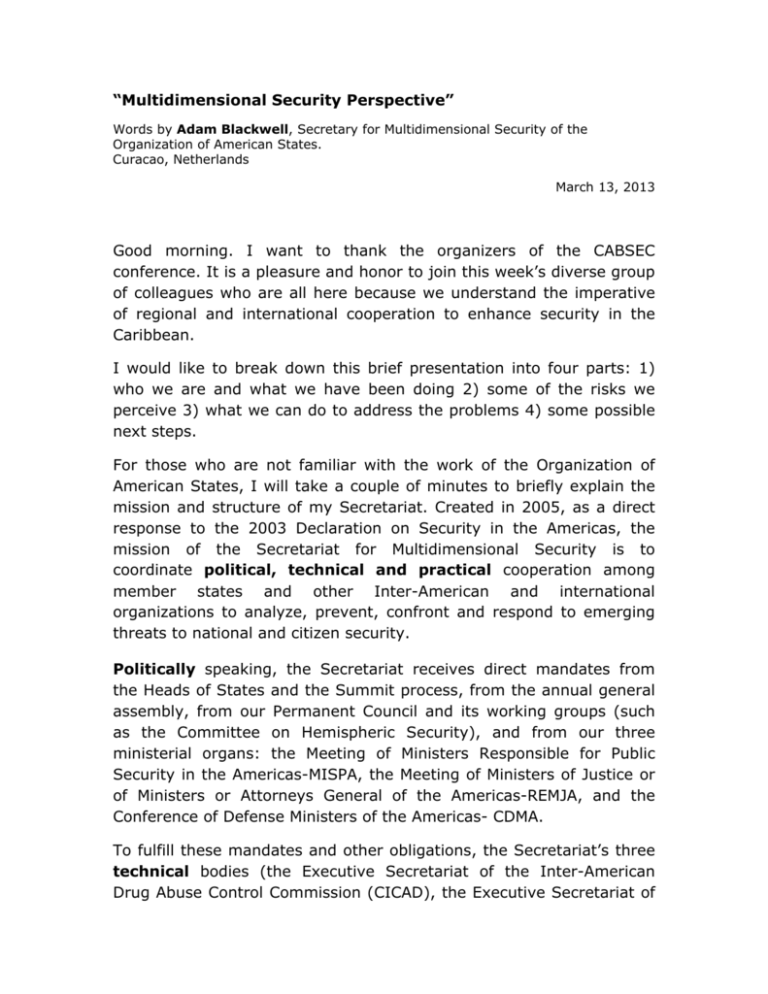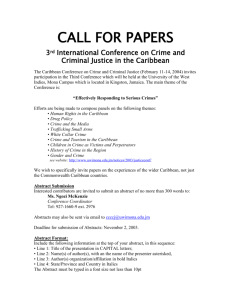curacao cabsec 13 - 3-13-2013.doc
advertisement

“Multidimensional Security Perspective” Words by Adam Blackwell, Secretary for Multidimensional Security of the Organization of American States. Curacao, Netherlands March 13, 2013 Good morning. I want to thank the organizers of the CABSEC conference. It is a pleasure and honor to join this week’s diverse group of colleagues who are all here because we understand the imperative of regional and international cooperation to enhance security in the Caribbean. I would like to break down this brief presentation into four parts: 1) who we are and what we have been doing 2) some of the risks we perceive 3) what we can do to address the problems 4) some possible next steps. For those who are not familiar with the work of the Organization of American States, I will take a couple of minutes to briefly explain the mission and structure of my Secretariat. Created in 2005, as a direct response to the 2003 Declaration on Security in the Americas, the mission of the Secretariat for Multidimensional Security is to coordinate political, technical and practical cooperation among member states and other Inter-American and international organizations to analyze, prevent, confront and respond to emerging threats to national and citizen security. Politically speaking, the Secretariat receives direct mandates from the Heads of States and the Summit process, from the annual general assembly, from our Permanent Council and its working groups (such as the Committee on Hemispheric Security), and from our three ministerial organs: the Meeting of Ministers Responsible for Public Security in the Americas-MISPA, the Meeting of Ministers of Justice or of Ministers or Attorneys General of the Americas-REMJA, and the Conference of Defense Ministers of the Americas- CDMA. To fulfill these mandates and other obligations, the Secretariat’s three technical bodies (the Executive Secretariat of the Inter-American Drug Abuse Control Commission (CICAD), the Executive Secretariat of the Inter-American Committee against Terrorism (CICTE) and the Department of Public Security (DPS) are charged with the implementation of declarations produced at the ministerial meetings and of resolutions passed by the OAS General Assembly. Each of these technical bodies has its own set of networks to address key themes such as: border and maritime security, cyber security, money laundering and terrorism financing, forensics, prisons, arms trafficking, drugs, and organized crime and terrorism, among others. These networks are made up of our country specialists and are in my view our real force multipliers. In my tenure as Secretary of Multidimensional Security, at the Organization of American States we have tried to build practical solutions that connect to the political and technical platform that we have at our disposal. The plethora of activities we carry out is united by a common philosophy, which we have termed “smart security.” Smart security dictates that all Secretariat actions entail a) an objective, evidence-based diagnosis of the problem, b) creation of proposals based on national and regional needs and capabilities, implemented in alliance with all relevant actors, c) a multidimensional and multi stakeholder focus ensuring systematic problem-solving, and d) a rigorous evaluation of results. We work in almost every country in the Americas, but the rising rates of violence in the Caribbean have made it a particular focus of our efforts. In 2012 we carried out more than 70 technical assistance activities in 16 countries in the Caribbean basin. We assisted member states to strengthen the capacities of national officials that work to: manage border security in land, sea and air, improve and expand firearms marking, prevent money laundering, reduce both drug demand and supply, enhance cyber security and combat organized crime, among others. So far In 2013, we have already executed more than 20 technical assistance missions. Our work in technical assistance and capacity building in the region has produced positive tangible results: among others, we have helped countries implement computer emergency response teams to tackle cyber threats; strengthened their ability to identify suspicious cargo; improve their detection techniques to expose cases of human trafficking and adopt better techniques to manage risks at airports. What are the risks we perceive? Our experience throughout the has indicated that the region indicates that there are indeed multiple threats to our national and citizen security and this in turn impacts economic and political stability at an enormous cost to development. I am not going to get into the litany of statistics; needless to say our region is too often a global leader - for the wrong reasons. Most of you will have heard the cliché “think local and go global” – well, this works for crime as well. Fuelled by the same forces of globalization that drive trade, communications and information, large and small criminal enterprises have an unprecedented influence on the lives and affairs of ordinary people, multinational companies and governments. The cross-border flow of global proceeds from criminal activities, corruption and tax evasion is estimated at over US$ 1 trillion, with illegal drugs and counterfeit goods accounting for 8% of world trade. The Inter-American Development Bank estimates that Latin America’s per capita GDP would be 25% higher if the region’s crime rate were reduced to the world average- this begs the question: what would the figure be for this region? As crime increases, so does the cost of doing business, which in turn reduces competitiveness and undermines social and community cohesion at the local level. This is even more of a concern in the Caribbean region, where the threats are many and scale and capacity to respond is a challenge. What can we do about the problems? Well, I introduced you to the concept of “smart security” a little earlier, and some of the main premises that it is based upon. But this notion of smart security also involves more innovative and creative approaches to tackling crime. The solution to the problem of insecurity is not necessarily more security; police, troops, heavy-handed anti-crime legislation. We know that we are not going to arrest our way out of the problem. Rather, we need to focus on areas like prevention – for instance, keeping the kids out of the gangs in the first place. And, while we need to ensure that those who do commit a crime are effectively punished, we should also strive to guarantee that said punishment is humane and that it fosters the reintegration of offenders back into society to lead useful and productive lives. There is significant potential in the region to come up with the type of solutions we are encouraging. In one country, with a very small grant from the OAS, a dedicated individual working out of the PM’s office built a national prevention strategy - the power of linking up families, communities, education, NGO’s, church groups and businesses to build a resilient community was considerable. Similarly, the OAS has a very successful program in the region called PROCCER. It is essentially a train-the-trainer program in prevention strategies. The independently evaluated results are most encouraging, as they show that those working with populations at risk are twice as likely to succeed if they are well trained and certified. Businesses too can work with community groups to promote “social networking”, helping them build a sense of community pride and share information about problems in their neighborhoods (e.g. where drugs are being sold). This information will help law enforcement officials in their allocation of scarce resources. Another example is our Orchestra of the Americas program. Launched in Saint Lucia, Jamaica and Haiti, we reached out to at risk youth in underprivileged neighborhoods, using music as a tool to keep kids off the streets and in school. This proved to be an extremely successful model for prevention and community development. The orchestra program has been expanded by national authorities in the Caribbean, and today the OAS is taking this model to Central America and using music education with gang members in El Salvador. A third example again involves working with the private sector and learning from its experience to devise innovative mechanisms to combat crime. The private and not for profit sector can teach us much. The CEO of a large rum distillery in one of the most violent states in Venezuela recounted his company’s innovative experience with gangs which continually assaulted employees in neighbouring communities. His company devised an “admittedly risky programme” of providing work to violent gang members. To their surprise, scores of gang members presented themselves for training and work. The company eventually brokered a peace between rival gangs and, in a relatively short time, the crime rate in the county dropped 90%. “We all know the importance of family but we didn’t understand the fact that gangs are families, providing the identity, sense of belonging and discipline when society fails to provide these needs.” Similarly, our POETA program, like the youth orchestra program I mentioned before, is specifically targeted to at risk youth – to keep them off the streets, away from drugs, and to promote civic education and community development. We’ve teamed up with private sector businesses like Microsoft to launch a technical and vocational trainings program for unemployed/underemployed youth. Already underway in the Caribbean (A&B, Dominica, Granada, ST. kitts & Nevis, Saint Lucia, ST. Vincent and the Grenadines), we launched a similar initiative in El Salvador. Building on the recent gang truce, we launched a project to train young women at Ilopango, a women’s penitentiary center. Last year on trip to Central America, I was able to visit the centre, and meet the women participating in the program, not surprisingly they felt better prepared to return to their communities. The same applies to law enforcement. I think frankly we too often play a numbers game and that perhaps our indicators are to blame. In my view it is not just a question of how many policemen you have per 100 thousand of population, but rather what kind of policemen. In the case of one country – not to be replicated - we were able to determine that out of approximately 15,000 police officers, only about 8 thousand of them were actually operating as police. The rest were either patronage appointments or policemen earning two or three salaries. I have also seen successful models where professional police services, with proper standards and structure, who are well recruited, well trained and certified, remunerated commensurate to the risk and vocation, are far more likely to have a positive relationship with the community, be less corrupt and solve more crimes. Similarly, we have seen overcrowded prisons and detention centers because the judicial system does not have the capability to process the numbers. Throwing people into jail might be a short term or immediate fix, but the mid to long term costs are incalculable and it is well documented that sending juveniles to the best university of crime does not generate happy outcomes. Aside from gang recruitment, prisons and correctional centres are struggling with overcrowding, poor sanitary conditions and documented cases of mistreatment Perhaps it is time to look at innovative solutions like drug treatment courts (DTCs) or other alternatives to incarceration. DTCs have proved to be an effective mechanism for treating addicts. Drug courts keep individuals in intensive treatment and close supervision for at least 1 year – this is long enough for it to work and there are clear and tangible results: in various countries, DTCs have effectively reduced crime, drug use and recidivism as well as prison populations, and have contributed to lowering the high costs associated with legal proceedings. We have existing DTC teams in Jamaica and new centers in Trinidad & Tobago and Suriname. Next Steps I am the first to recognize that our work is still largely incomplete. Over the past few years, the risks and threats faced by Caribbean islands have become increasingly interconnected. Today, criminality in one member state will likely have repercussions in neighboring islands and countries. This new security scenario will require new models based on standards and a more coordinated regional approach to security and strong leadership. I would also say that for smaller jurisdictions there is the need to share and combine capabilities. Is it necessary to have a forensics lab in every country/province or state? Is it possible and feasible to develop a regional cyber security capability? How can we better link up our military and coast guard capabilities? In areas where resources are not readily accessible, sharing information and resources is crucial. We heard a number of interventions here yesterday to that effect, and I fully concur with them. We also know we need better knowledge and intelligence, tools for identifying problems, observatories with common methodologies and structure and information-sharing networks. SMS has developed a series of programs to address these areas. We established a pilot program for security sector diagnosis to assess the security risks of a given national security system. Unlike other security sector evaluations, the diagnosis carried out under “smart security” focused on the relationship between various institutions of a security system – between the public and private bodies, and between government sectors, including the police, judiciary, and social programs. The assessment concluded with a confidential report submitted to government officials, analyzing the weaknesses and possible means of strengthening their security system. In all the assessments, the final reports recommended actions to improve intersectorial communication and more effective coordination efforts. We also have well-established national observatories on Drugs Citizen Security. Throughout the year we collect and analyze crime drug-related data, and publish our findings. These annual reports be easily accessed on the SMS website. We are willing to share standardized methodology and even input the data. and and can our Like we are doing for the Attorney Generals in Central America, we can also share a secure communication platform across countries, if that would help. These are just some ideas and I am sure there are more. We need to identify the best practice models and standards, document them and, if they are fit for purpose, then look at their transferability from one jurisdiction to another. A further example of this effort is a landmark agreement which we have signed with AMERIPOL to place two police liaison officers in my Secretariat to begin documenting successful policing practices and models that can be shared across jurisdictions. Bottom line - Solutions must be built on an accurate diagnosis of the problems, tailored to the local environment, and must adopt a multi stakeholder horizontal approach in its delivery and evaluation. The international community needs to do a much better job of coordination. We are working closely with colleagues both regionally (such as CARICOM-IMPACS) and internationally (most recently with the Kingdom of the Netherlands) to build what I hope will be a common action plan. Through this we hope to leverage the strength of each organization to build a much tighter and coordinated response. If anyone in this room has an interest in meeting on the sidelines of the conference please let me know. We are here to learn and discuss with you how to do this better.









